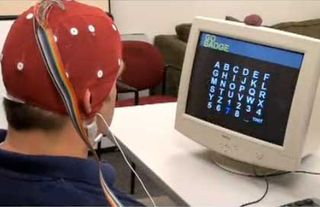Mind-Reading Device Sends Twitter Messages

Twitter messages are so short — a 140-character limit — that you have to really think about what you want to say.
For Adam Wilson, thinking is all he has to do.
Earlier this month, Wilson thought of a tweet (the name for a post to the social networking site) and poof, his computer read his mind and sent the darn thing. At just 23 characters, Wilson's message, "using EEG to send tweet," was done with a computer setup that interprets brain waves.
The technology could one day help patients who otherwise can't communicate finally talk to the outside world. Among them are people with amyotrophic lateral sclerosis (ALS), brain-stem stroke or high spinal cord injury.
Story continues below. Watch how it works:
{{ video="LS_090423-brain-twit" title="Brain Interface Creates Twitter Messages" caption="University of Wisconsin-Madison biomedical engineering doctoral student Adam Wilson creates Twitter messages using brain waves. Credit: UW-Madison" }}
Step forward
Sign up for the Live Science daily newsletter now
Get the world’s most fascinating discoveries delivered straight to your inbox.
Other mind-reading devices have been developed recently. Other research has suggested brain activity could be monitored before decisions are made, perhaps with a mind-reading hat that would predict what we'll do. One shines near-infrared light into the noggin to glean thoughts.
And some brain-computer interface systems employ an electrode-studded cap wired to a computer to detect electrical signals in the brain and translate them into physical actions, such as moving a cursor on a screen.
Wilson and his colleagues wanted more.
"We started thinking that moving a cursor on a screen is a good scientific exercise," said Justin Williams, a University of Wisconsin-Madison assistant professor of biomedical engineering and Wilson's adviser. "But when we talk to people who have locked-in syndrome or a spinal-cord injury, their No. 1 concern is communication."
In collaboration with research Gerwin Schalk and colleagues at the Wadsworth Center in Albany, N.Y., Williams and Wilson developed an interface that involves a keyboard displayed on a computer screen. Here's how it works:
"All the letters come up, and each one of them flashes individually," Williams explained. "And what your brain does is, if you're looking at the 'R' on the screen and all the other letters are flashing, nothing happens. But when the 'R' flashes, your brain says, 'Hey, wait a minute. Something's different about what I was just paying attention to.' And you see a momentary change in brain activity."
Like texting
Wilson, who used the interface to post the Twitter update, likens it to texting on a cell phone.
"You have to press a button four times to get the character you want," he said of texting. "So this is kind of a slow process at first."
However, as with texting, users improve as they practice using the interface. "I've seen people do up to eight characters per minute," Wilson said.
The micro-blogging Twitter site, with its basis in very short messages, fits locked-in users' capabilities, Williams said. Tweets are displayed on a user's profile page and delivered to other Twitter users who have signed up to receive them.
"So someone could simply tell family and friends how they're feeling today," Williams said. "People at the other end can be following their thread and never know that the person is disabled. That would really be an enabling type of communication means for those people, and I think it would make them feel, in the online world, that they're not that much different from everybody else. That's why we did these things."
Funding for the project came from the university, the National Institutes of Health and the Wisconsin Alumni Research Foundation.

